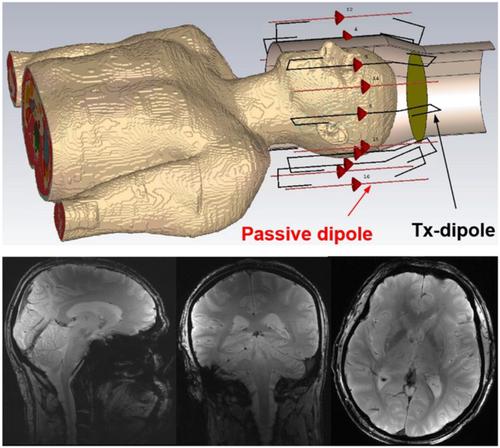当前位置:
X-MOL 学术
›
NMR Biomed.
›
论文详情
Our official English website, www.x-mol.net, welcomes your
feedback! (Note: you will need to create a separate account there.)
Folded-end dipole transceiver array for human whole-brain imaging at 7 T
NMR in Biomedicine ( IF 2.7 ) Pub Date : 2021-05-12 , DOI: 10.1002/nbm.4541 Nikolai I Avdievich 1 , Georgiy Solomakha 2 , Loreen Ruhm 1 , Anton V Nikulin 1, 3 , Arthur W Magill 4 , Klaus Scheffler 1, 3
NMR in Biomedicine ( IF 2.7 ) Pub Date : 2021-05-12 , DOI: 10.1002/nbm.4541 Nikolai I Avdievich 1 , Georgiy Solomakha 2 , Loreen Ruhm 1 , Anton V Nikulin 1, 3 , Arthur W Magill 4 , Klaus Scheffler 1, 3
Affiliation

|
The advancement of clinical applications of ultrahigh field (UHF) MRI depends heavily on advances in technology, including the development of new radiofrequency (RF) coil designs. Currently, the number of commercially available 7 T head RF coils is rather limited, implying a need to develop novel RF head coil designs that offer superior transmit and receive performance. RF coils to be used for clinical applications must be robust and reliable. In particular, for transmit arrays, if a transmit channel fails the local specific absorption rate may increase, significantly increasing local tissue heating. Recently, dipole antennas have been proposed and used to design UHF head transmit and receive arrays. The dipole provides a unique simplicity while offering comparable transmit efficiency and signal-to-noise ratio with the conventional loop design. Recently, we developed a novel array design in our laboratory using a folded-end dipole antenna. In this work, we developed, constructed and evaluated an eight-element transceiver bent folded-end dipole array for human head imaging at 7 T. Driven in the quadrature circularly polarized mode, the array demonstrated more than 20% higher transmit efficiency and significantly better whole-brain coverage than that provided by a widely used commercial array. In addition, we evaluated passive dipole antennas for decoupling the proposed array. We demonstrated that in contrast to the common unfolded dipole array, the passive dipoles moved away from the sample not only minimize coupling between the adjacent folded-end active dipoles but also produce practically no destructive interference with the quadrature mode of the array.
中文翻译:

用于 7 T 人体全脑成像的折叠端偶极收发器阵列
超高场 (UHF) MRI 临床应用的进步在很大程度上取决于技术的进步,包括新射频 (RF) 线圈设计的开发。目前,市售的 7 T 头射频线圈的数量相当有限,这意味着需要开发能够提供卓越发射和接收性能的新型射频头线圈设计。用于临床应用的射频线圈必须坚固可靠。特别是,对于发射阵列,如果发射通道发生故障,则局部比吸收率可能会增加,从而显着增加局部组织加热。最近,偶极子天线被提出并用于设计 UHF 头部发射和接收阵列。偶极子提供独特的简单性,同时提供与传统环路设计相当的传输效率和信噪比。最近,我们在实验室使用折叠端偶极天线开发了一种新颖的阵列设计。在这项工作中,我们开发、构建和评估了一个八元件收发器弯曲折叠端偶极子阵列,用于在 7 T 下进行人体头部成像。在正交圆极化模式下,该阵列表现出超过 20% 的传输效率和明显更好的传输效率比广泛使用的商业阵列提供的全脑覆盖。此外,我们评估了无源偶极子天线以解耦所提出的阵列。我们证明,与常见的未折叠偶极子阵列相比,远离样品的无源偶极子不仅可以最大限度地减少相邻折叠端有源偶极子之间的耦合,而且实际上不会对阵列的正交模式产生破坏性干扰。我们在实验室中使用折叠端偶极天线开发了一种新颖的阵列设计。在这项工作中,我们开发、构建和评估了一个八元件收发器弯曲折叠端偶极子阵列,用于在 7 T 下进行人体头部成像。在正交圆极化模式下,该阵列表现出超过 20% 的传输效率和明显更好的传输效率比广泛使用的商业阵列提供的全脑覆盖。此外,我们评估了无源偶极子天线以解耦所提出的阵列。我们证明,与常见的未折叠偶极子阵列相比,远离样品的无源偶极子不仅可以最大限度地减少相邻折叠端有源偶极子之间的耦合,而且实际上不会对阵列的正交模式产生破坏性干扰。我们在实验室中使用折叠端偶极天线开发了一种新颖的阵列设计。在这项工作中,我们开发、构建和评估了一个八元件收发器弯曲折叠端偶极子阵列,用于在 7 T 下进行人体头部成像。在正交圆极化模式下,该阵列表现出超过 20% 的传输效率和明显更好的传输效率比广泛使用的商业阵列提供的全脑覆盖。此外,我们评估了无源偶极子天线以解耦所提出的阵列。我们证明,与常见的未折叠偶极子阵列相比,远离样品的无源偶极子不仅可以最大限度地减少相邻折叠端有源偶极子之间的耦合,而且实际上不会对阵列的正交模式产生破坏性干扰。
更新日期:2021-07-02
中文翻译:

用于 7 T 人体全脑成像的折叠端偶极收发器阵列
超高场 (UHF) MRI 临床应用的进步在很大程度上取决于技术的进步,包括新射频 (RF) 线圈设计的开发。目前,市售的 7 T 头射频线圈的数量相当有限,这意味着需要开发能够提供卓越发射和接收性能的新型射频头线圈设计。用于临床应用的射频线圈必须坚固可靠。特别是,对于发射阵列,如果发射通道发生故障,则局部比吸收率可能会增加,从而显着增加局部组织加热。最近,偶极子天线被提出并用于设计 UHF 头部发射和接收阵列。偶极子提供独特的简单性,同时提供与传统环路设计相当的传输效率和信噪比。最近,我们在实验室使用折叠端偶极天线开发了一种新颖的阵列设计。在这项工作中,我们开发、构建和评估了一个八元件收发器弯曲折叠端偶极子阵列,用于在 7 T 下进行人体头部成像。在正交圆极化模式下,该阵列表现出超过 20% 的传输效率和明显更好的传输效率比广泛使用的商业阵列提供的全脑覆盖。此外,我们评估了无源偶极子天线以解耦所提出的阵列。我们证明,与常见的未折叠偶极子阵列相比,远离样品的无源偶极子不仅可以最大限度地减少相邻折叠端有源偶极子之间的耦合,而且实际上不会对阵列的正交模式产生破坏性干扰。我们在实验室中使用折叠端偶极天线开发了一种新颖的阵列设计。在这项工作中,我们开发、构建和评估了一个八元件收发器弯曲折叠端偶极子阵列,用于在 7 T 下进行人体头部成像。在正交圆极化模式下,该阵列表现出超过 20% 的传输效率和明显更好的传输效率比广泛使用的商业阵列提供的全脑覆盖。此外,我们评估了无源偶极子天线以解耦所提出的阵列。我们证明,与常见的未折叠偶极子阵列相比,远离样品的无源偶极子不仅可以最大限度地减少相邻折叠端有源偶极子之间的耦合,而且实际上不会对阵列的正交模式产生破坏性干扰。我们在实验室中使用折叠端偶极天线开发了一种新颖的阵列设计。在这项工作中,我们开发、构建和评估了一个八元件收发器弯曲折叠端偶极子阵列,用于在 7 T 下进行人体头部成像。在正交圆极化模式下,该阵列表现出超过 20% 的传输效率和明显更好的传输效率比广泛使用的商业阵列提供的全脑覆盖。此外,我们评估了无源偶极子天线以解耦所提出的阵列。我们证明,与常见的未折叠偶极子阵列相比,远离样品的无源偶极子不仅可以最大限度地减少相邻折叠端有源偶极子之间的耦合,而且实际上不会对阵列的正交模式产生破坏性干扰。











































 京公网安备 11010802027423号
京公网安备 11010802027423号